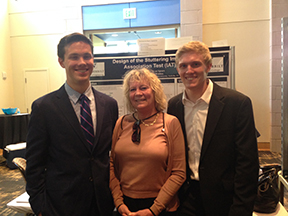Vanderbilt Kennedy Center (TN UCEDD, LEND, IDDRC) Investigator Develops Tool to Assess Implicit Biases Related to Individuals Who Stutter
July 18, 2016

|
More than 3 million Americans stutter. Stuttering is characterized by disruptions in the production of speech sounds, usually begins in early childhood, and can persist throughout life. The documented stigmatizing attitudes of others put children who stutter at an increased risk for experiences such as aggression and bullying, and therefore the disorder often has a negative impact on children's development in educational, social, and vocational spheres of life.
Vanderbilt Kennedy Center (TN UCEDD, LEND, IDDRC) Investigator Tedra Walden, Ph.D., professor of Psychology and Human Development, has studied the effects that stuttering has on early social and emotional development of young children, particularly focusing on the way in which the social environment influences children's emotional responses.
"People often have negative attitudes about traits, personality attributes, and the overall potential of those who stutter," said Walden. "It's not uncommon for people to believe that people who stutter have psychosocial problems, and that's just not true. The effect is often discrimination against those who stutter, and because most children begin stuttering between 3 to 5 years of age, these negative attitudes can influence children as they are first forming self-esteem and self-identity. So, it is important that we better understand negative attitudes, stereotypes, and prejudices held by those who exert significant influence over life outcomes of those who stutter."
A number of studies have documented these negative attitudes, but Walden says these studies have used measures that only reveal explicit, self-reported biases. She has become interested in uncovering underlying implicit negative attitudes that exist, which people may not be aware of or hide in their desire to appear socially appropriate. What are the biases that people hold, but either consciously or unconsciously hide?
The Implicit Association Task (I.A.T.) is an effective method used to identify implicit attitudes, but most versions rely on words on the screen to assess how people's brains automatically make associations between concepts and attributes. Visual cues would not be effective in assessing responses to stuttering, particularly for children too young to read, so Walden began working with Biomedical Engineering students Michael Kremer and Ryan Spears to develop an audio version of the I.A.T.
"I knew what needed to be done, but I didn't have the programming skills necessary to get this new method together," said Walden. "I submitted a request to the School of Engineering and connected with Ryan and Michael, who were looking for an idea for their Senior Design project. Together, we worked with an audio-visual engineer to develop the sounds of both stuttered and non-stuttered words, and then we set about the task of creating a new and reliable way of collecting this data."
Over the course of the year in development, Walden, Kremer, and Spears tested the modified I.A.T. with 20 people, and 20 out of 20 showed a bias against the stuttered words. The initial results affirmed and have fueled Walden's impetus to further her research on identifying implicit biases and their effects on life outcomes of those who stutter.
Through a research project that Walden recently submitted to the National Institutes of Health, she hopes to examine both implicit and explicit attitudes in several groups of people who are most significant in the lives of young children who stutter: the children themselves and their parents; nonstuttering peers and their parents; teachers; and therapists. Her analyses will combine the perceptions of these groups to predict children's own self-perceptions as well as children's, parents', peers', teachers' and therapists' attitudes that predict children's self-perceptions.
"You have to wonder how these implicit attitudes affect quality of life for people who stutter, said Walden. "They have poor social outcomes, poor academic outcomes, and lower employment rates. They are often thought of as less smart and less capable, and if those around them are fueling these misperceptions, we desperately need to be aware of that and address the problem."
Walden is also enthusiastic about the diverse potential the I.A.T. audio version has for future research. She hopes it will be used and modified by other investigators who are interested in furthering our understanding of implicit biases that have potentially damaging and discriminatory effects on the social and emotional development of young children.
To learn more about the audio subtest of the I.A.T., contact [email protected].







